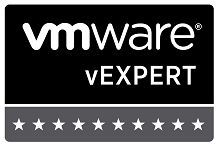תיקונים מעניינים ב-ESXi:
Use of the invoke-vmscript command displays an error
When you use the invoke-vmscript PowerCLI command scripts on a virtual machine, the script fails with the following error message:
The guest operations agent could not be contacted.
This issue is resolved with this release.
Component-based logging and advanced configurations added to hostd log level
To avoid difficulties in getting appropriate logs during an issue, this release introduces component-based logging by dividing the loggers into different groups and prefixing them. Also, new advanced configuration allows you to change hostd log's log level without restarting.
This issue is resolved in this release
Long running vMotion operations might result in unicast flooding
When using the multiple-NIC vMotion feature with vSphere 5, if vMotion operations continue for a long time, unicast flooding is observed on all interfaces of the physical switch. If the vMotion takes longer than the ageing time that is set for MAC address tables, the source and destination host start receiving high amounts of network traffic.
This issue is resolved in this release.
ESXi host might display a compliance failure error message after applying Host Profile successfully to the host
When you successfully apply Host Profile to an ESXi host, the host become noncompliant and might display an error message similar to the following:
IPv4 routes did not match
This issue occurs when two or more VMkernel port groups use the same subnet.
This issue is resolved in this release.
When the quiesced snapshot operation fails the redo logs are not consolidated
When you attempt to take a quiesced snapshot of a virtual machine, if the snapshot operation fails towards the end of its completion, the redo logs created as part of the snapshot are not consolidated. The redo logs might consume a lot of datastore space.
This issue is resolved in this release. If the quiesced snapshot operation fails, the redo log files are consolidated.
Adding a new hard disk to a virtual machine that resides on a Storage DRS enabled datastore cluster might result in Insufficient Disk Space error
If the size of a virtual disk that you add to a virtual machine residing on a Storage DRS enabled datastore is greater than the free space available on the datastore, SDRS might migrate another virtual machine out of the datastore to allow sufficient free space for adding the virtual disk. The Storage vMotion operation is completed but the subsequent addition of the virtual disk to the virtual machine might fail and an error message similar to the following might be displayed:
Insufficient Disk Space
This issue is resolved in this release.
Reinstallation of ESXi 5.1 does not remove the Datastore label of the local VMFS of an earlier installation
Reinstallation of ESXi 5.1 with an existing local VMFS volume retains the Datastore label even after the user chooses the overwrite datastore option to overwrite the VMFS volume.
This issue is resolved in this release.
ESXi 5.x scripted installation incorrectly warns that USB or SD media does not support VMFS, despite –novmfsondisk parameter in kickstart file
If you perform a scripted installation to install ESXi 5.1 on a disk that is identified as USB or SD media, the installer might display the following warning message:
The disk (<disk-id>) specified in install does not support VMFS.
This message is displayed even if you have included the --novmfsondisk parameter for the install command in the kickstart file.
This issue is resolved in this release.
Unable to deploy virtual machines using template files
You might be unable to deploy virtual machine using the template files. This issue occurs when the template files and .vmtx files are not updated after the datastore resignature process is performed.
This issue is resolved in this release by updating the .vmtx virtual machine files of the template with the latest resignatured datastore path.
When you vMotion Windows Server 2008 virtual machines from ESX/ESXi 4.0 to ESXi 5.1 and then perform a storage vMotion the quiesced snapshots fail
A storage vMotion operation on ESXi 5.1 by default sets disk.enableUUID to true for a Windows Server 2008 virtual machine, thus enabling application quiescing. Subsequent quiesce snapshot operation fails till the virtual machine undergoes a power cycle.
This issue is resolved in this release.
After VMware Tools installation the guest operating system name changes from Microsoft Windows Server 2012 (64-bit) to Microsoft Windows 8 (64-bit)
After you create Microsoft Windows Server 2012 (64-bit) virtual machines and install VMware Tools, the guest operating system name changes from Microsoft Windows Server 2012 (64-bit) to Microsoft Windows 8 (64-bit).
This issue is resolved in this release.
מיכאל.
